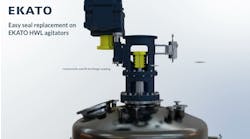Ease of use, advanced sensors and 3D modeling are making drones more attractive to chemical companies searching for safe, swift and cost-effective inspection routines.
Shell, for example, has shifted its thinking about drones. Now, instead of treating them as specialty tools for explicit tasks, the company embeds them into operations as the preferred way of working.
“They offer a cost effective and safe way to rapidly gather imagery of out-of-reach spaces and large geographic areas,” notes Victor Vertregt, digital lead engineering for Shell Chemicals Park, Moerdijk, The Netherlands.
Today, multiple Shell locations own and operate drones from unspecified suppliers and use artificial intelligence (AI) algorithms to extract key information from the data generated.
In fact, in November last year, the company added autonomous integrity recognition to its in-house Open AI Initiative ecosystem of AI-based technologies available to the process industries. Cloud-processed data coming from inspections carried out with drones, robots and handheld devices enable inspectors objectively to evaluate issues, identify items that have been overlooked, reduce the time needed at the desk generating reports, and improve inputs to maintenance planning.
“We are increasing our use of specialty drones, such as caged drones and drones with non-destructive-testing sensors, too,” adds Vertregt.
Current Applications
He cites several examples of how company sites now are deploying drones.
At Shell’s Deer Park refinery in Texas, drones inspect the tank farm to collect data as opposed to inspectors physically visiting the tanks.
According to Vertregt, the surveillance robotics team is looking to build upon such initiatives by doing this kind of repetitive data-collection activity across wider areas of a facility.
At Shell’s Pennsylvania Petrochemicals Complex, a $6-billion project to make polyethylene from shale-gas-derived ethane, drones take construction progress snapshots, producing dimensionally accurate 3D models from aerial imagery that cover the entire 400-acre footprint of the site (see Lead Image above).
Meanwhile, Shell’s Moerdijk plant is using the company’s Autonomous Integrity Recognition Program (AIRP). By combining drones and AI-based image analyses, the facility has achieved higher detection rates of corrosion and insulation — especially on top of piping bridges and columns.
In addition, several Shell chemical facilities and refineries use caged drones to inspect large storage tanks from the inside, avoiding the need for internal scaffolding.
As well as rising to the technical challenges of drone use, Shell also is challenging regulatory orthodoxy.
“Regulations typically require drones to stay within range of the pilot’s vision, limiting their geographic reach and operational scope. Shell has been a pioneer in operating drones beyond visual line of site (BVLOS) which brings up unique regulatory challenges. Shell has executed successful acquired BVLOS permits in Australia and the U.S.A. to execute successful commercial proof-of-concept deployments,” explains Vertregt.
“Shell continues to drive innovation in the BVLOS space with a variety of technology partners as we believe that BVLOS permits are key to expanding drone use outside of traditional use cases. This has been used to check remote well sites in Australia and right-of-way surveys of pipelines in Canada,” he adds.
The result of all this experience is that the benefits of drone use are stacking up.
“The key benefits center around their ability to improve personal safety and reduce operational costs such as scaffold erection or travel to remote locations, plus the ability to gather more-frequent and -thorough data at locations like piping bridges where access was previously impossible,” stresses Vertregt.
Similarly, using drones in combination with visual-analysis software enables much-more-precise and consistent data interpretation. Through the company’s AIRP, the AI algorithm judges every corrosion indication, providing an objective prioritization to any identified defect and allowing robust historical analysis.
Meanwhile, the ability to create visual representation from drone shots has increased significantly, too. At the Moerdijk facility, a drone survey of the flare stacks and chimneys enables creation of 3D mesh models. This allows the surveying company to indicate, in 3D, the location of defects, providing the maintenance and engineering teams with very intuitive data to work with.
Vertregt also believes that Shell’s asset-owned-drone program provides a visible symbol of digital transformation in action, which then inspires colleagues across company assets to leverage technology to improve their work and generate efficiencies.
Looking ahead, Vertregt sees opportunities to use automated drone flights in conjunction with emerging image-analysis software. This, in turn, will enable fully automating repetitive tasks, such as verification of perimeter security at processing plants or daily tank-farm rounds.
“We also see an opportunity in further democratizing drone usage by extending the reach of our asset-owned-drone program and having trained drone pilots in all the relevant departments, including engineering, operations and maintenance. This will lower the threshold even further to use drones for simple and low-frequency jobs, while creating a healthy development funnel for new drone-related use cases,” he concludes.
More Successes
Long a user of what the company refers to as unmanned aerial systems (UAS), Chevron is leveraging the technology to reduce field risks to personnel, boost personnel efficiency by getting more done in less time, improve data consistency and historical documentation, enhance project planning to achieve more accurate project estimates, and decrease process unit downtime.
Four current UAS use-cases include: visual inspections of power poles, tank roofs and equipment interiors as well as routine project planning.
In the case of tank-roof visual inspections, one UAS pilot now can check more than 20 tanks per day, a substantial boost from the three-to-five per day possible previously.
Routine project planning pre-UAS, involved at least three to five Chevron personnel with different functional backgrounds traveling multiple times to a project site to scope out — e.g., take measurements, identify obstacles, locate tie-ins, determine cut/fill volumes for material management, etc. — and plan a given project. Typically, it took over 100 personnel hours just to plan routine facility projects. Project planning personnel were exposed to inherent field risks such as wildlife, slips/trips/falls, and other process-specific risks and also expended several hours of travel time to get between the office and field sites.
“Now, we can have one UAS pilot travel to a field site, capture aerial imagery, process it, and share it with all relevant project stakeholders for planning,” says a spokeswoman.
“This reduces carbon by removing vehicles from the road, improves safety as there is less risk from vehicular travel and less exposure to inherent field risks, improves personnel efficiency because they spend less time planning a project due to more details being accessible and/or available, and improves the accuracy of project estimates which are now more likely to come in at the planned budget rather than over/under it,” she adds.
As with Shell, Chevron is working with regulatory agencies such as the U.S. Federal Aviation Administration to better define and clarify the process for achieving BVLOS operations. The company is regularly monitoring and evaluating “self-launching” capabilities, too.
“The key strength of UAS is the breadth of use-cases it can support. However, the challenge is the depth of capabilities, i.e., the more payloads that are mounted on a UAS, the shorter the battery life. As the future unfolds, to fully cover the complexity of our facility operations we will need to apply an integrated and coordinated approach between aerial, mobile ground-based, and stationary ground-based sensors,” she concludes.
Broader Interest
Drone specialist Flyability, Paudex, Switzerland, is finding growing enthusiasm within the chemical industry about the technology and how its use can be expanded.
Marketing manager Zacc Dukowitz points to a range of different applications of the company’s Elios 2 drones.
In 2017, for example, the technology helped Novozymes, Blair, Neb., speed up its fermentation plant inspection process — along the way finding anomalies in tanks and agitator shafts that were missed by traditional inspections carried out only a few weeks previously.
Lessons learned from the pilot convinced Novozymes that a single drone flight could completely inspect a fermenter — lowering the inspection time, including health-safety-environmental procedures, to less than ten minutes.
The company also checked whether a drone could solve another recurring challenge at the facility — gathering information on containers in its storage warehouse. The annual cross-check of inventory relied on a crane to capture the serial number of each container and check whether it is open or closed. Opting for a drone instead reduced the process to a few minutes instead of the usual several hours.
Another example Dukowitz cites is Yara’s fertilizer facility at Ambès, France. The company shuts down the site for three weeks every two years for in-depth inspections of all the assets there. The first stage is a visual inspection; the number of employees on site during this almost quadruples to 450.
In a 2021 pilot, the company used a drone to carry out some of these inspections.
“By looking at the screen on the remote control during the tests, what I saw using the drone was of an equal quality to what I can see using traditional [inspection] methods. When we reviewed the footage on a larger screen the quality was impeccable. You could even zoom in to look at more details, and so on. For visual inspection, it’s perfect,” says inspection service manager Vianney Amrhein.
According to Yara, the immediate benefits of using the Elios 2 to collect visual data instead of sending in a person would directly address two primary challenges it faces during the inspection period: safety and speed.
Given how quickly and easily the drone can capture high-quality visual data, the company now is exploring the possibility of adapting preventive maintenance procedures and may use the drone to gain quicker access to hard-to-reach places more often.
Latest Model
Feedback from such companies, plus long-term testing with Dow, Chevron and others, drove Flyability to develop the Elios 3, which was released in mid-May. It’s specifically designed for flying in confined spaces, primarily to perform inspections.
“In four years of development, we spent thousands of hours in R&D, but we also performed field tests constantly to see how the prototypes were performing in the field and get feedback from customers. In total, we did over 200 field tests to make the Elios 3,” notes Dukowitz.
During development, Flyability particularly focused on the demand it was getting from chemical customers for the ability to create 3D models and to use a wider range of sensors. Flexibility also was important. The Elios 3 is a modular platform both in terms of hardware to accommodate new sensors and accessories, and in terms of software that can integrate with customers’ own technology.
A major advantage of this is situational awareness (Figure 2). “The 3D Live Map allows you to know exactly where you are so you can fly out the same way you came in. It also has safety implications because there were some situations in which an inspector would have to enter a confined space to watch the drone fly. Not anymore,” emphasizes Dukowitz.
Then there’s its impact on the development of digital twins. Chemical companies increasingly are creating 3D models of entire plants that then can be used to compare with future drone-provided models to identify surface defects and other asset deterioration.
This, in turn, leads to 3D reporting: “Being able to show exactly where a defect is on a 3D model has huge potential for improving maintenance workflows,” he notes.
Correcting blueprints is another benefit; Flyability already has seen several instances where the 3D Live Map shows a different layout than that contained in the original plans.
“In general, the feedback was incredibly positive. Clients were amazed by the stability of the Elios 3, how easy it is to fly, and the quality of the LiDAR-enabled 3D Live Map. Ease of use was a huge value add for companies in both chemicals and oil and gas since it lowers the barrier to entry for their personnel. Many companies have reported getting brand new pilots doing inspection flights the same day they pick up a remote control for the first time,” notes Dukowitz.
Flyability’s production team now is working to add new payload capabilities to the Elios 3, driven by demands from chemical companies to meet inspection requirements.
He also points out that a few inspections typically pay back the investment for a drone. Manual inspections often require erecting and then taking down scaffolding, which incur additional cost and can be very time consuming.
For the future, autonomous flight is high on the agenda, with Flyability hoping one day to supply an indoor drone that can fly into a confined space, collect inspection data, and fly out without the need for a live pilot. “The data is what inspectors need, and this would be a more immediate path to provide that,” adds Dukowitz.
He offers some advice to chemical companies wondering about the virtues of drone technology: “If Dow is using robotics to keep people out of dangerous spaces, including confined spaces, then it might be worth considering at least testing similar approaches — especially if doing so has the potential not only to save your company money, but to save lives. For our specific technology, I’d recommend doing a proof of concept, where they perform an actual mission on site.”




